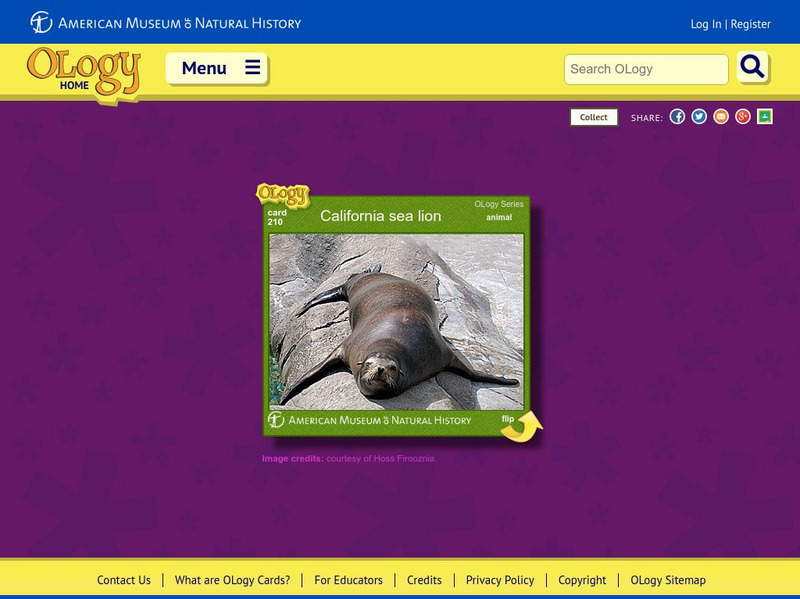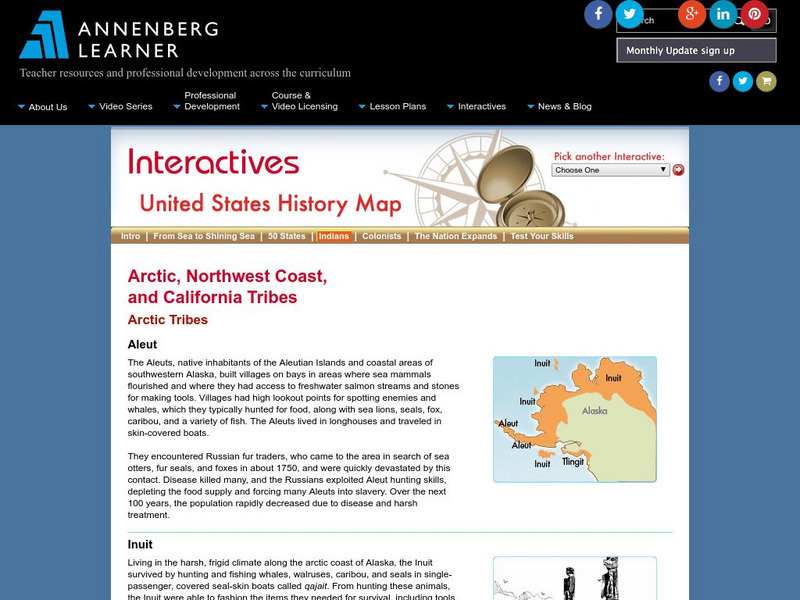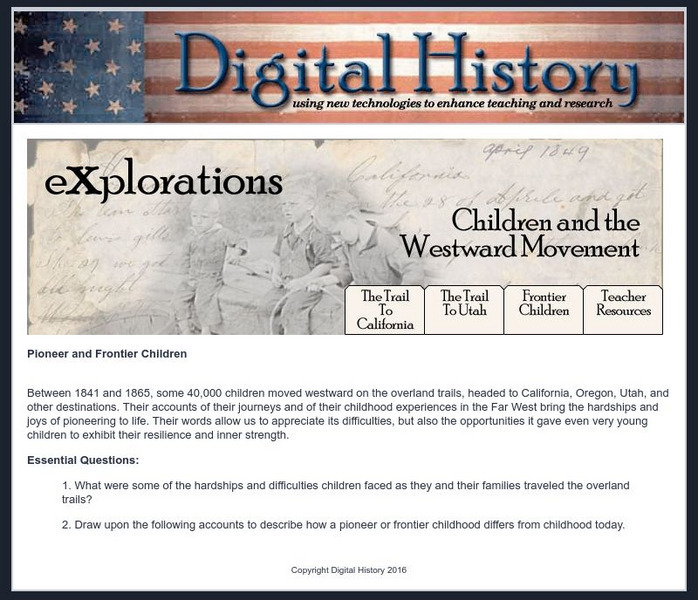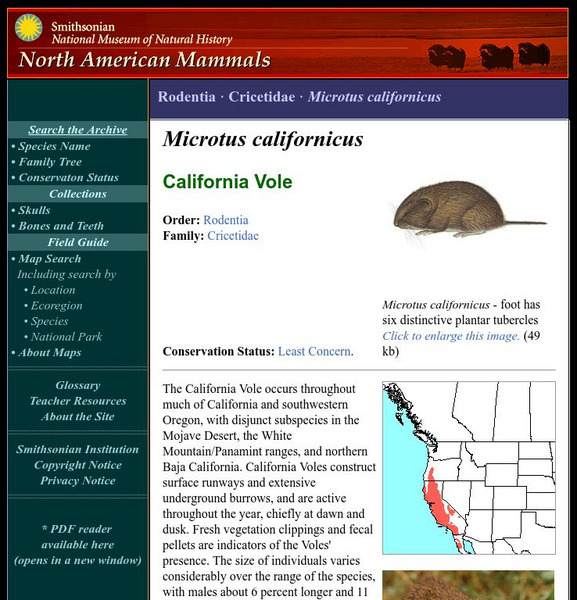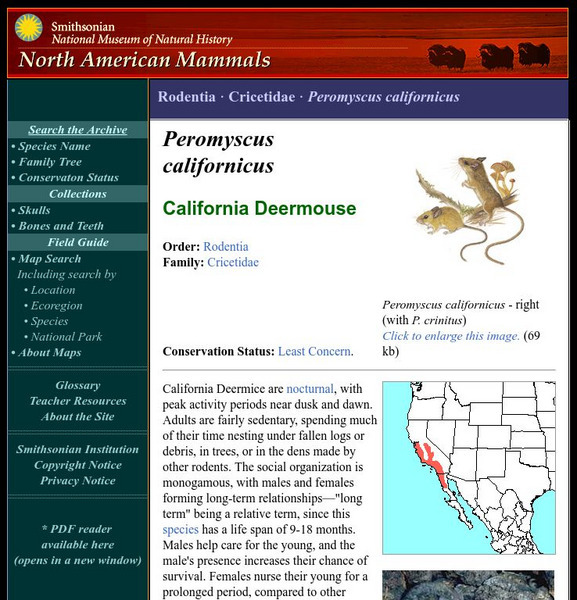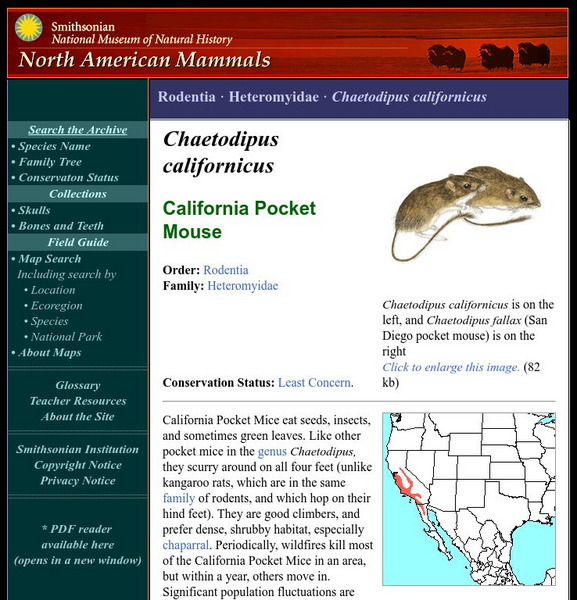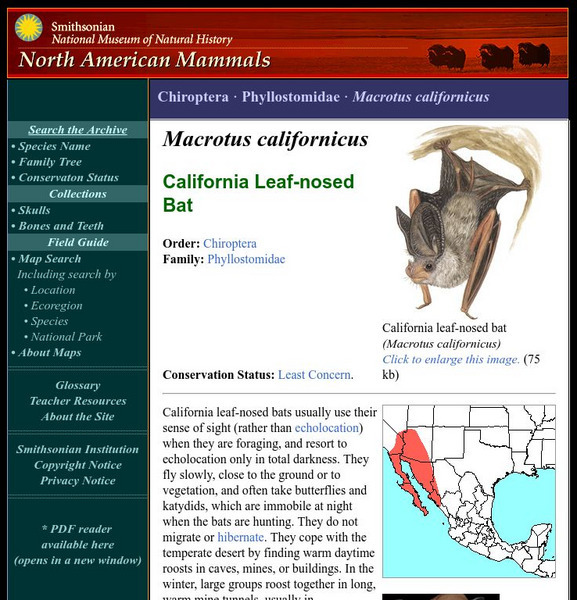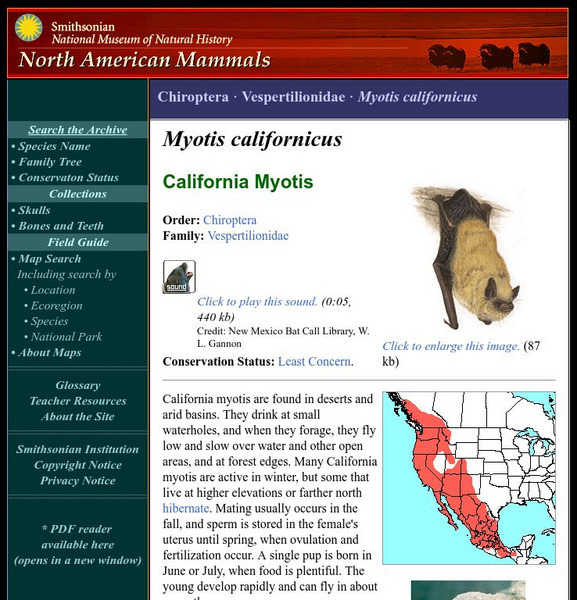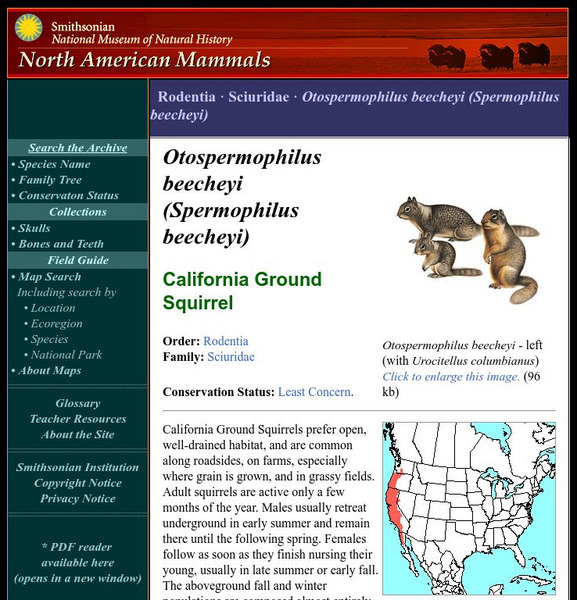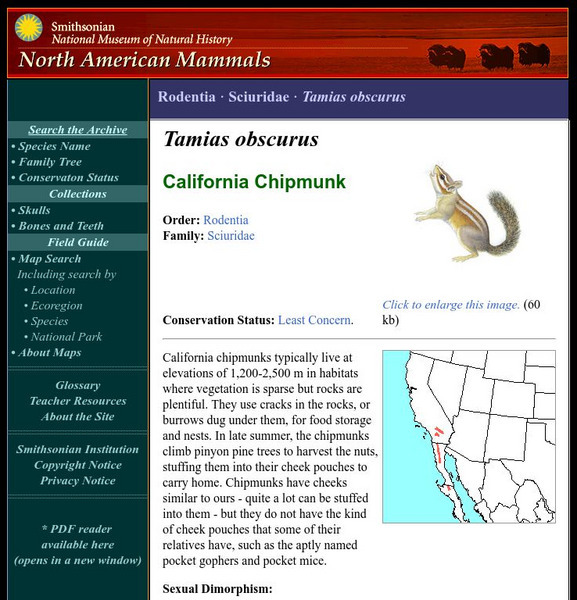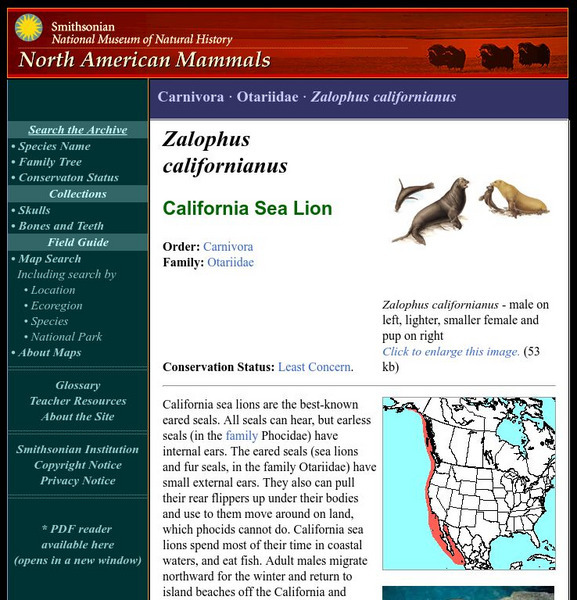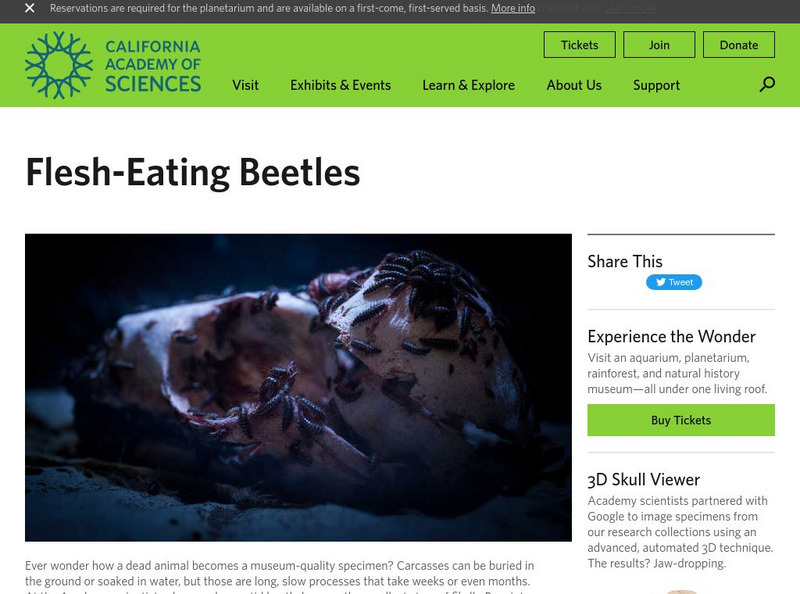American Museum of Natural History
American Museum of Natural History: California Condor O Logy Card
Flip this interactive OLogy card to start learning about the California condor. Review some fast facts about condors and answer multiple-choice and fact-or-fiction questions to test your understanding.
American Museum of Natural History
American Museum of Natural History: California Sea Lion O Logy Card
Flip over this interactive OLogy card and start learning bite-size pieces of useful information about the California sea lion, such as its habitat, diet, and physical characteristics.
Read Works
Read Works: Panning for History
[Free Registration/Login Required] Students read about a Boy Scout trip that goes panning for rocks, minerals, and gold to learn more about history. A question sheet is available to help students build skills in reading comprehension.
50 States
50 States: California (Ca)
Find here a collection of links to information about the state of California. Categories include facts, government, geography, education, people, attractions, history, industry, and miscellaneous.
Other
California Museum: Discover: Fun With Crafts: State Symbols of California
Instructions and templates for creating the state symbols of California out of paper and other easy-to-find materials.
Other
Sbc an Uncommon Mission
Read about the California missions that have contributed to California state history. View paintings of all twenty-one missions created by artist, Jerome Tupa. Includes a variety of activities, quizzes, puzzles, etc. to add to the...
Annenberg Foundation
Annenberg Learner: Us History Map: Arctic, Northwest Coast and California Tribes
A brief description of some of the main Native American tribes that lived in the Arctic, along the Northwest Coast, and in California.
Other
Historic Trails: Oregon/california Trails
Find a map of the Oregon Trail and California Trail and click Historical Trails tab to discover the hardships and daily grind of traveling on the Oregon Trail.
Digital History
Digital History: Explorations: Children and the Westward Movement
Read first-hand accounts to learn about the children who made the journey west to California, Utah, Oregon and other destinations in the mid-1800s.
Ducksters
Ducksters: History: California Gold Rush for Kids
Kids learn about the California Gold Rush from the Old West on this site. Thousands of people move to the west to search for gold and strike it rich.
Ducksters
Ducksters: History: Pony Express for Kids
Kids learn about the Pony Express from the Old West on this site. Riders would swap horses at stations to deliver the mail faster to and from California.
Ducksters
Ducksters: History: Timeline of Westward Expansion for Kids
Kids learn the timeline of Westward Expansion of the United States on this site. Follow the timeline of how pioneers and settlers moved west of the Mississippi all the way to California.
University of California
Ucmp: Life Has a History
This is a very good introduction to the role evolution plays in the development of biodiversity. These topics and extinction are explained with the use of colorful interactive pictures.
Smithsonian Institution
National Museum of Natural History: American Mammals: California Vole
The California Vole occurs throughout much of California and southwestern Oregon, with disjunct subspecies in the Mojave Desert, the White Mountain/Panamint ranges, and northern Baja California. California Voles construct surface runways...
Smithsonian Institution
National Museum of Natural History: American Mammals: California Deermouse
California Deermice are nocturnal, with peak activity periods near dusk and dawn. Adults are fairly sedentary, spending much of their time nesting under fallen logs or debris, in trees, or in the dens made by other rodents. Learn more...
Smithsonian Institution
National Museum of Natural History: American Mammals: California Kangaroo Rat
California Kangaroo Rats require open areas away from the humidity of the coast in northern California and southern Oregon. They seem to need well-drained soil, and after a rain can be seen pushing mud out of their burrows. Learn more...
Smithsonian Institution
National Museum of Natural History: American Mammals: California Pocket Mouse
California Pocket Mice eat seeds, insects, and sometimes green leaves. Like other pocket mice in the genus Chaetodipus, they scurry around on all four feet (unlike kangaroo rats, which are in the same family of rodents, and which hop on...
Smithsonian Institution
National Museum of Natural History: American Mammals: California Leaf Nosed Bat
California leaf-nosed bats usually use their sense of sight (rather than echolocation) when they are foraging, and resort to echolocation only in total darkness. They fly slowly, close to the ground or to vegetation, and often take...
Smithsonian Institution
National Museum of Natural History: American Mammals: California Myotis
California myotis are found in deserts and arid basins. They drink at small waterholes, and when they forage, they fly low and slow over water and other open areas, and at forest edges. Learn more about the Myotis californicus, more...
Smithsonian Institution
National Museum of Natural History: American Mammals: California Ground Squirrel
California Ground Squirrels prefer open, well-drained habitat, and are common along roadsides, on farms, especially where grain is grown, and in grassy fields. Adult squirrels are active only a few months of the year. Learn more about...
Smithsonian Institution
National Museum of Natural History: American Mammals: California Chipmunk
California chipmunks typically live at elevations of 1,200-2,500 m in habitats where vegetation is sparse but rocks are plentiful. They use cracks in the rocks, or burrows dug under them, for food storage and nests. Learn more about the...
Smithsonian Institution
National Museum of Natural History: American Mammals: California Sea Lion
California sea lions are the best-known eared seals. All seals can hear, but earless seals (in the family Phocidae) have internal ears. Learn more about the Zalophus californianus, more commonly known as a California Sea Lion, in this...
California Academy of Sciences
California Academy of Sciences: Flesh Eating Beetles!
Get the gory low-down of flesh-eating beetles and find out how they are put to work in natural history museums.
University of California
University of California, Berkeley Art Museum: Han Dynasty Tomb Artifact
Learn about Han Dynasty culture through an examination of a tomb artifact created to be buried with a rich landowner.
Other popular searches
- 4th Grade California History
- California History Missions
- California History Unit Plan
- Folktales California History
- California History in 1920s
- California History Ranchos
- California History Gold Rush
- California History 8.3.7
- California History Skit
- California History Lessons
- California History 837
- California History Ranch's

